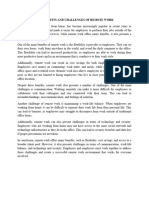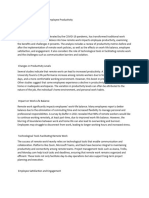Operating Remotely
Operating Remotely
Uploaded by
exequel sanicoCopyright:
Available Formats
Operating Remotely
Operating Remotely
Uploaded by
exequel sanicoOriginal Description:
Original Title
Copyright
Available Formats
Share this document
Did you find this document useful?
Is this content inappropriate?
Copyright:
Available Formats
Operating Remotely
Operating Remotely
Uploaded by
exequel sanicoCopyright:
Available Formats
Operating remotely
What it is: We assisted the world's transition to remote operations, from industrial facilities to fire alarm
systems. For instance, Fire personnel can control a building's fire panel using the cloud thanks to
Honeywell's Connected Life Safety Systems. During this time, a crucial process control facility in Orange,
Texas, was switched to remote operations by our Honeywell Process Solutions.
Why it's innovative: Because of shutdowns, many facility maintenance teams are operating with smaller
staffs and having less access to facilities. Less workers can be on-site but essential duties can still be
completed using remote operations.
Remote Work
Remote work (also known as work from home [WFH] or telecommuting) is a
type of flexible working arrangement that allows an employee to work from
remote location outside of corporate offices. For employees who can complete
work offsite, this arrangement can help ensure work-life balance, access to
career opportunities or reduced commutation costs. Benefits for the company
include increased employee satisfaction and retention, increased productivity
and cost savings on physical resources. Remote work arrangements can be
temporary or permanent, part-time or full-time, occasional or frequent. Remote
work requires policies governing equipment use, network security and
performance expectations.
Working remotely has traditionally held a bad reputation,
but more and more companies are adopting work-from-
home policies. Check out the latest trends in remote work.
In the past, remote employees have had a bad reputation. Many employers believed
their workforce would be too easily distracted at home, where their managers couldn’t
keep an eye on their direct reports.
Remote work was very rare a decade ago. Working from home was usually only
available as a special arrangement to accommodate families in specific cases.
However, teleconferencing and telework technology has advanced to the point where
some businesses thrive with completely remote teams. In fact, it’s not uncommon for
businesses to allow their employees to work from home once or twice a week.
Remote work can also help prevent the spread of illness, helping companies avoid lost
productivity and protecting public health. For example, the outbreak of COVID-19
prompted many employers to shift to a remote work model for all employees possible in
a bid to limit the spread of the coronavirus.
To determine the effectiveness of communication technology and working remotely,
we’ll examine the history of working remotely, the current state of the workforce, and
predictions for the future of remote employment.
Is remote working effective?
A decade ago, most employers would have balked at the idea of employees regularly
working from home. One major concern most employers had for working remotely was
a loss of productivity. How productive and efficient can an employee be when they’re
not under constant supervision by co-workers and supervisors?
To better understand the effectiveness of remote work, Airtasker surveyed 1,004 full-
time employees – 505 of whom were remote employees – throughout the U.S. about
their work habits and productivity. The results indicate that remote workers are actually
more productive than their office-based counterparts. The study found the following:
Remote employees work an additional 1.4 more days per month than in-office
employees, which is nearly 17 additional workdays a year.
Remote employees take longer breaks on average than office employees (22
minutes versus 18 minutes, respectively), but they work an additional 10 minutes
a day.
Office workers are unproductive for an average of 37 minutes a day, not
including lunch or breaks, whereas remote employees are unproductive for only
27 minutes.
15% of remote workers said their boss distracted them from work, which is less
than the 22% of office-based employees who said the same thing.
You might also like
- Main Project On Work From HomeDocument53 pagesMain Project On Work From HomeMallavarapu Srikanth100% (3)
- Modern Defendo History PDFDocument85 pagesModern Defendo History PDFprd67% (3)
- Remote Work TrendsDocument4 pagesRemote Work TrendsMateusz AsmusNo ratings yet
- Remote Work ToolkitDocument18 pagesRemote Work ToolkitmslylawildNo ratings yet
- Woring RemotelyDocument1 pageWoring RemotelyYaos YaosNo ratings yet
- Impact of Remote and Hybrid WorkDocument7 pagesImpact of Remote and Hybrid Work23pba158ajiteshNo ratings yet
- Rise of Remote WorkDocument4 pagesRise of Remote WorkJosiah DalisayNo ratings yet
- Working From Home MeaningDocument7 pagesWorking From Home Meaningsam prasanthNo ratings yet
- The Rise of Remote WorkDocument2 pagesThe Rise of Remote WorkbarteksribdNo ratings yet
- Remote Work Vs TelecommutingDocument3 pagesRemote Work Vs TelecommutingJaeNo ratings yet
- Work From HomeDocument17 pagesWork From Home5trrz6p9gzNo ratings yet
- The Future of Remote Work: Pros and ConsDocument3 pagesThe Future of Remote Work: Pros and Consyrfgdvb27No ratings yet
- MR Milleur 3Document16 pagesMR Milleur 3kangadaniel0887No ratings yet
- A Study Into The Effects of An Increasingly Teleworking SocietyDocument4 pagesA Study Into The Effects of An Increasingly Teleworking Societystonehenge5No ratings yet
- RecupDocument16 pagesRecupkangadaniel0887No ratings yet
- The Benefits and Challenges of Remote WorkDocument1 pageThe Benefits and Challenges of Remote WorkAngBagong Barangay SanJuanNo ratings yet
- Remote Work Pros and ConsDocument1 pageRemote Work Pros and ConssfgNo ratings yet
- UCF COVID 19 Remote Work Guidelines2Document7 pagesUCF COVID 19 Remote Work Guidelines2Ang angNo ratings yet
- Remote EmployeesDocument8 pagesRemote EmployeesSusan KondoweNo ratings yet
- Benefits of Remote Working For EmployersDocument9 pagesBenefits of Remote Working For EmployersHiền Bùi ThuNo ratings yet
- The 15-Second Commute: A Work-from-Home Guide for Telecommuters, Managers and EmployersFrom EverandThe 15-Second Commute: A Work-from-Home Guide for Telecommuters, Managers and EmployersNo ratings yet
- TeleworkingDocument6 pagesTeleworkingКарина КолесникNo ratings yet
- 2012 Executive DistributedWorkReportDocument13 pages2012 Executive DistributedWorkReportdesignedanddeliveredNo ratings yet
- Organisational Behaviour WFH Research PaperDocument15 pagesOrganisational Behaviour WFH Research PaperBunnyNo ratings yet
- The Influence of Teleworking On The Job Satisfaction, Employee Commitment and Productivity of The Employees During The COVID-19 PandemicDocument11 pagesThe Influence of Teleworking On The Job Satisfaction, Employee Commitment and Productivity of The Employees During The COVID-19 PandemicProme SahaNo ratings yet
- How To Manage Remote Employees by Owl LabsDocument27 pagesHow To Manage Remote Employees by Owl LabsLaucha XeneizeNo ratings yet
- TRS6 Test 2 WritingDocument3 pagesTRS6 Test 2 WritingQuốc AnhNo ratings yet
- 1Document2 pages1mundranehal3834No ratings yet
- @annisuphere #Idea Sheet - Future of Remote WorkDocument12 pages@annisuphere #Idea Sheet - Future of Remote WorkninaNo ratings yet
- Impact of Remote Work On Productivity and Work-Life BalanceDocument2 pagesImpact of Remote Work On Productivity and Work-Life Balance022MausamNo ratings yet
- The Impact of Remote Work On Employee Wellbeing and ProductivityDocument23 pagesThe Impact of Remote Work On Employee Wellbeing and ProductivityFarhan NayaziNo ratings yet
- CheggDocument7 pagesCheggHiệp TrầnNo ratings yet
- Work From Home: Made By: Phalit Gupta Uday Patel Dhruvin Gheewala Rahul GawadeDocument11 pagesWork From Home: Made By: Phalit Gupta Uday Patel Dhruvin Gheewala Rahul GawadePhalit GuptaNo ratings yet
- Learning Unit 1Document11 pagesLearning Unit 1tsholofelokeikelame3No ratings yet
- The Impact of Remote Work On Productivity and WorkDocument3 pagesThe Impact of Remote Work On Productivity and WorkXaine PineraNo ratings yet
- Benefits of Remote Work and How It Fuels Business Success - GigsterDocument1 pageBenefits of Remote Work and How It Fuels Business Success - GigsterdimahmadyNo ratings yet
- Home Office, Mobile Office: Managing Remote WorkingDocument20 pagesHome Office, Mobile Office: Managing Remote WorkingConstanzaSCNo ratings yet
- Flexibility at WorkpaceDocument15 pagesFlexibility at Workpaceravalaanvi05No ratings yet
- A Study On Impact of WFHDocument35 pagesA Study On Impact of WFHNithyasri KathiravanNo ratings yet
- Guideline Remote Flexible WorkingDocument15 pagesGuideline Remote Flexible WorkingshadijahNo ratings yet
- Blog 3Document2 pagesBlog 3Zaineb MatiullahNo ratings yet
- The Hybrid Work From Home Guideline TemplateDocument17 pagesThe Hybrid Work From Home Guideline Templategaddi.ma.jannelleNo ratings yet
- A306 Management Information Systems and The Networked Society AssignmentDocument4 pagesA306 Management Information Systems and The Networked Society Assignmentapi-3695734No ratings yet
- Effective Telecommuting: Learn how to work efficiently and productively at homeFrom EverandEffective Telecommuting: Learn how to work efficiently and productively at homeNo ratings yet
- How Will Workplaces Change Due To CovidDocument3 pagesHow Will Workplaces Change Due To CovidsdddNo ratings yet
- The Impact of Remote Work On Employee Performance and WellDocument2 pagesThe Impact of Remote Work On Employee Performance and WellDrazen JovicNo ratings yet
- Overload: How Good Jobs Went Bad and What We Can Do about ItFrom EverandOverload: How Good Jobs Went Bad and What We Can Do about ItRating: 2.5 out of 5 stars2.5/5 (2)
- Remote Work During COVID-19 On 2021Document6 pagesRemote Work During COVID-19 On 2021Keren H. Morales RomeroNo ratings yet
- Wa0001.Document5 pagesWa0001.Sachin SharmaNo ratings yet
- Remote Work After COVID-19: Gartner For HRDocument13 pagesRemote Work After COVID-19: Gartner For HRnombresitoNo ratings yet
- The Hopeful Telecommuter Answers: 1. If I Were Jennifer, I Would First State My Background and The Work I Do ForDocument7 pagesThe Hopeful Telecommuter Answers: 1. If I Were Jennifer, I Would First State My Background and The Work I Do ForJamie DayagbilNo ratings yet
- Material 14Document6 pagesMaterial 14rafidahad2711No ratings yet
- Remote Work MattersDocument4 pagesRemote Work MattersNA_RaviNo ratings yet
- Homeworking: A Guide To Good PracticeDocument40 pagesHomeworking: A Guide To Good PracticeFelipe Arellano Arellano100% (1)
- ArticleDocument5 pagesArticleFahad AbdaliNo ratings yet
- Top Work From Home Productivity Statistics Tech - CoDocument1 pageTop Work From Home Productivity Statistics Tech - CoDanielle ThompsonNo ratings yet
- Influence of Work From Home On Quality of Work Life of Employeesworking in Bpo Industry, PuneDocument7 pagesInfluence of Work From Home On Quality of Work Life of Employeesworking in Bpo Industry, PuneIJAR JOURNALNo ratings yet
- 3d-Printed Engine PartsDocument2 pages3d-Printed Engine Partsexequel sanicoNo ratings yet
- Quantum Computing Becomes RealityDocument2 pagesQuantum Computing Becomes Realityexequel sanicoNo ratings yet
- Visibility To What's in The AirDocument2 pagesVisibility To What's in The Airexequel sanicoNo ratings yet
- UV-C Light Used in New WaysDocument3 pagesUV-C Light Used in New Waysexequel sanicoNo ratings yet
- Jane Austen Art of CharacterizationDocument4 pagesJane Austen Art of CharacterizationSara SyedNo ratings yet
- Pamphlet 03 - Scientific Method and The Burden of Proof PDFDocument2 pagesPamphlet 03 - Scientific Method and The Burden of Proof PDFgordomanotasNo ratings yet
- Course Pack MBA 663 D SP21 Part1Document121 pagesCourse Pack MBA 663 D SP21 Part1梁世睿No ratings yet
- Dicionário Ilustrado Infantil FR PDFDocument72 pagesDicionário Ilustrado Infantil FR PDFPaulo BonifácioNo ratings yet
- Shared Kitchen Toolkit - A Practical Guide To Planning, Launching, and Managing A Shared-Use Commercial KitchenDocument166 pagesShared Kitchen Toolkit - A Practical Guide To Planning, Launching, and Managing A Shared-Use Commercial KitchenJustin Uhrig CrandallNo ratings yet
- Convert Thesis Into BookDocument5 pagesConvert Thesis Into Bookbsqw6cbt100% (3)
- Match The Pictures With The Right Description Match The Pictures With The Right DescriptionDocument9 pagesMatch The Pictures With The Right Description Match The Pictures With The Right DescriptionM MerryNo ratings yet
- The Lament - 20240514 - 164942 - 0000Document14 pagesThe Lament - 20240514 - 164942 - 0000jolo Del Rosario GeneraoNo ratings yet
- Affixes ListDocument2 pagesAffixes ListJhai HerreraNo ratings yet
- Law For The Entrepreneur and ManagersDocument44 pagesLaw For The Entrepreneur and ManagersEbun EgbewunmiNo ratings yet
- 55 A 00550041 Soal Uas MJN StrategikDocument2 pages55 A 00550041 Soal Uas MJN StrategikFRASETYO ANGGA SAPUTRA ARNADINo ratings yet
- RiffsDocument31 pagesRiffsmatheusgadelha253No ratings yet
- Module 2 Lab - Installing Domain ControllersDocument5 pagesModule 2 Lab - Installing Domain ControllersEdgar lealNo ratings yet
- 100% Scheduling Case StudyDocument48 pages100% Scheduling Case StudySeanElverdNo ratings yet
- The Cask of AmontilladoDocument3 pagesThe Cask of AmontilladocrazybobblaskeyNo ratings yet
- CFCPR 3 PDFDocument168 pagesCFCPR 3 PDFece142No ratings yet
- COVID-19 Testing Report FinalDocument25 pagesCOVID-19 Testing Report FinalNick ReismanNo ratings yet
- Ug III CC August 2020Document68 pagesUg III CC August 2020DeeshaNo ratings yet
- 1.1a Introduction To Legal Med PDFDocument2 pages1.1a Introduction To Legal Med PDFBea SamonteNo ratings yet
- Tau Human AuxileriesDocument2 pagesTau Human Auxileriessinisterbutt100% (4)
- Soal Latihan Bahasa Inggris Kelas 2Document3 pagesSoal Latihan Bahasa Inggris Kelas 2Dash Da Gomez0% (2)
- A Study On Meriiboy Ice Cream Company With Special Reference To Human Resource DepartmentDocument46 pagesA Study On Meriiboy Ice Cream Company With Special Reference To Human Resource DepartmentSruthy psNo ratings yet
- El Paso Shooter John of God Connection (Substack)Document10 pagesEl Paso Shooter John of God Connection (Substack)MemoryHoldNo ratings yet
- Study On Social Media Marketing of Amazon..............................Document15 pagesStudy On Social Media Marketing of Amazon..............................Sunil KumarNo ratings yet
- TCW Chapter 7Document16 pagesTCW Chapter 7Lanestosa Ernest Rey B.No ratings yet
- Rosa Bonheur PDFDocument10 pagesRosa Bonheur PDFIolandaTomiucNo ratings yet
- Recertification - Acronis #CyberFit Cloud Tech FundamentalsDocument78 pagesRecertification - Acronis #CyberFit Cloud Tech FundamentalsFalcon NogueraNo ratings yet
- Von Appen AffidavitDocument6 pagesVon Appen Affidavitkaimin.editorNo ratings yet
- Ezekiel and The LandDocument29 pagesEzekiel and The Landloveland22No ratings yet





























































































